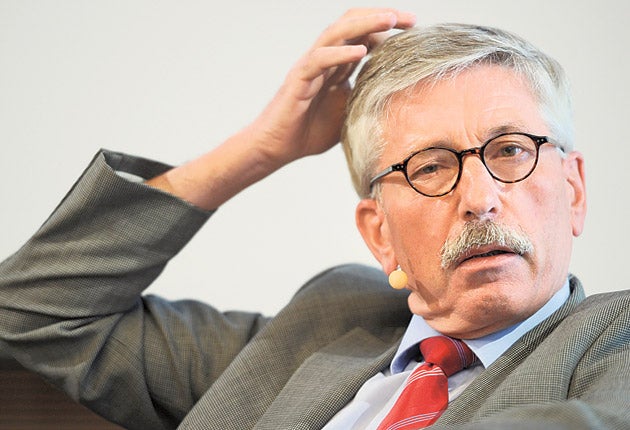
Integration, assimilation and racism are all terms which have suddenly acquired a momentum of their own in the Germany of Angela Merkel, the country's first woman Chancellor.
This is partly because the nation's foremost conservative leader chose recently to publicly dismiss Germany's post-war attempts to create a multicultural society as a "complete failure".
Ms Merkel's outburst appears to have been prompted in turn by a huge and wholly unexpected surge in public appetite for racial theories that have been propagated in a new best-selling book by Thilo Sarrazin, a former German Bundesbank board member and Berlin city government finance minister.
Mr Sarrazin argues that Muslims and blacks who live in Germany are chronic under-achievers who are more likely than whites to commit crimes and become dependent on welfare payments. He says that Muslims and blacks breed faster than white Teutons and he fears waking up one day in a Germany where headscarves and mosques are dominant.
To drive the message home his book has been titled Germany Is Doing Away With Itself. It has topped the bestseller lists and sparked a raging and clearly long-overdue controversy about immigration since its publication last September.
However, those concerned that Germany is treading on disturbingly familiar ground will be relieved to know that a powerful antidote to Mr Sarrazin's theories was provided just a few days ago by Arte, the Franco-German television channel.
The station aired the experiences of veteran undercover journalist Günter Wallraf, who spent the best part of a year travelling around Germany disguised as a black man and armed with a hidden camera.
Kwami Ogomo, a supposed refugee from Somalia, is dressed up in an amateurish fashion in the film, and looks as if he has just been performing in the 1960s TV series The Black and White Minstrel Show. His face is obviously "blacked up", he wears a curly black wig and a garish patterned shirt, yet only one person manages to see through the disguise during the entire 80-minute documentary.
To say that Kwami Ogomo is exposed to racism during his odyssey would be a gross understatement. On a train, admittedly surrounded by neo-Nazi football supporters from east Germany, he comes close to getting very badly beaten up. Wallraf admits that had a policewoman not intervened, he might not have survived.
But the violent racists in the film are almost less disturbing than the non-violent, supposedly respectable, members of German society. There is, for example, the Cologne landlady who hears Wallraf speak perfect German on the telephone as he asks to rent a room from her. When he arrives on the doorstep the landlady turns white with shock and flatly refuses him."I didn't realise he was soooo black," she tells a white woman posing as the next applicant sent in by the programme.
Then there is the manager of an Alsatian dog training school who tells Kwami that it costs €300 to join. The white woman sent in afterwards is told it costs €30. Wallraf says that his experiences have made him horribly aware of the ordeals suffered daily by ordinary black people living in Germany.
Even in Kreuzberg, the discrimination is growing
It would be nice to assume that what many regard as " cool" Berlin's hippest and most ethnically diverse district of Kreuzberg is immune from such provincial racism. The borough has one of the highest concentrations of immigrants in Germany. Many of them are Turks. Much of the rest of the population is comprised of artists and members of the city's alternative scene. Kreuzberg has been represented by a Green Party MP for decades.
However, the day-to-day experiences of Augustine Thullah, who is from Sierra Leone, have stripped away some of the liberal, multicultural gloss.
Mr Thullah has worked as a car mechanic in Kreuzberg for more than 18 years. Whenever new customers arrive and spot him standing in the repair shop, they ask him: "Could you take me to the boss please?" Mr Thullah usually responds by sending the customers to the repair shop office. The office then sends the customers back to Mr Thullah.
"Most people cannot imagine a German garage run by a black man," he told a German anti-racism project. Thankfully Kreuzberg's fondness for things alternative is helping to dispel such prejudice: "The fact is we don't have any bosses in our garage, we are all bosses. Our business is the biggest collective in Germany."
Crisis in the gentrified east
After decades in which Berlin rents and property prices have barely shifted upwards, the city now suddenly finds itself gripped by a form of aggressive gentrification. Property prices in now trendy inner-city districts of former communist east Berlin have gone up by a staggering 20 per cent over the past few years, according to a survey published last week.
But if weekend events in the east Berlin district of Friedrichshain are anything to go by, gentrification means violence. Seven hundred baton-wielding and helmeted riot police retreated after being confronted by a crowd of 3,000 stone and firework-throwing anti-gentrification protesters on Saturday night. There were running street battles and dozens of people were injured.
The trouble was caused by the Berlin city government's decision to evict squatters from a Friedrichshain apartment block they had occupied since 1992. The squatters were offered alternative accommodation in a house in a next-door borough, but they refused to go there. The house was "too far away".

Join our commenting forum
Join thought-provoking conversations, follow other Independent readers and see their replies